Epidural anesthesia in childbirth, indications, contraindications

Epidural anesthesia is one of the most popular types of anesthesia, which anesthetizes only a limited space.Such an anesthesia is carried out in different parts of the spinal cord - the choice depends on which area of the body it is supposed to perform surgical intervention.
Table of contents: Table of contents: How epidural anesthesia works How epidural anesthesia is done Epidural anesthesia during labor When epidural anesthesia is contraindicated Advantages and disadvantages of epidural anesthesia in cesarean section Possible consequences of epidural anesthesia and complications Spinal / epidural / epidural / caudal anesthesiaHow does epiduralAnesthesia
 Anesthetic injected( a drug that has an analgesic effect) through the epicDural space falls into the subarachnoid.There, it blocks the nerve impulses that pass through the spinal roots.This is how the loss of sensitivity and muscle relaxation occurs, and it is present only in that part of the body where impulses were specifically blocked.For example, during the operation of cesarean section epidural anesthesia is done in the lumbar spine.
Anesthetic injected( a drug that has an analgesic effect) through the epicDural space falls into the subarachnoid.There, it blocks the nerve impulses that pass through the spinal roots.This is how the loss of sensitivity and muscle relaxation occurs, and it is present only in that part of the body where impulses were specifically blocked.For example, during the operation of cesarean section epidural anesthesia is done in the lumbar spine.
This type of anesthesia can be performed in two ways:
- Long-term anesthesia - Small doses of an anesthetic drug are administered periodically through the catheter, used for postoperative analgesia or in severe / complicated natural childbirth;
- single injection of anesthetic - the catheter is not used in such cases, the dose of the drug is large, this type of epidural anesthesia is used for caesarean section.
How do epidural anesthesia
Before starting to conduct the type of anesthesia under consideration for performing routine operations, the patient is specially prepared:
- explains the principle of the action of epidural anesthesia, possible consequences;
- for 10-12 hours the patient should not eat food, and for 2 hours - water;
- reveals the presence / absence of an allergic reaction to medications;
- measures the patient's temperature, pulse and blood pressure;
- examines the patient's blood - general analysis, coagulogram, blood group and Rh factor.
Only after such a preparatory process it is possible to proceed directly with epidural anesthesia. Stages of the procedure:
- , a catheter is inserted into the peripheral vein by puncture, the patient is connected to the infusion system;
- put an oxygen mask, a cuff for measuring blood pressure;
- the necessary tool is prepared: anesthetic( most commonly used Lidocaine), tampons with alcohol, saline, needle for puncture with a special conductor, adhesive plaster, syringe and catheter;
- we lay / seat the patient - he should sit or lie on his side, his head should be tilted as much as possible;
- determined the exact location of the epidural anesthesia;
- disinfection with tampons with alcohol at the site of injection of anesthetic;
- puncture of the epidural cavity and administration of the drug.
Note: is responsible for anesthesiologist not only the administration of an anesthetic drug in the epidural cavity, but also further monitoring of the patient's condition - control of pressure, pulse rate, respiration.
Epidural anesthesia during labor
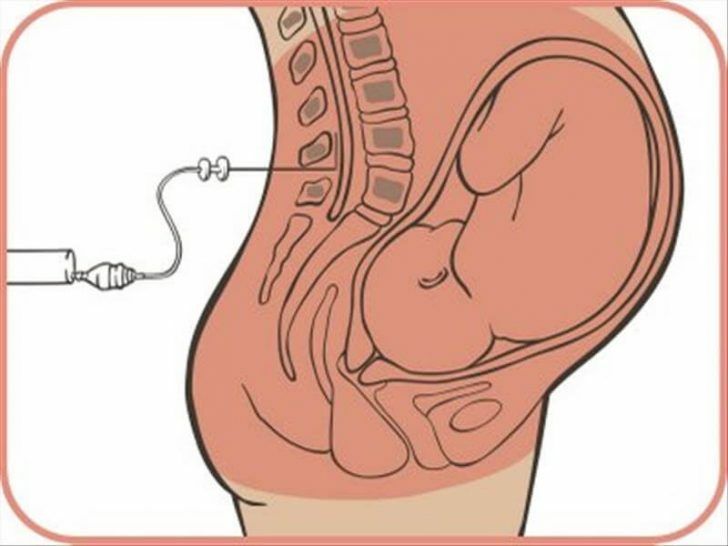
Most often, the type of anesthesia in question is used in gynecological / obstetric practice. Indications for epidural anesthesia are:
Caesarean section.- .It can be planned according to medical indices( multiple pregnancy or an already existing cesarean section in anamnesis) and emergency( premature birth, sudden deterioration of the woman and / or fetus).
- Pregnancy, taking place with a complication in the form of chronic fetal hypoxia - a child in the womb lacks oxygen.
- History of somatic diseases in women, which occur in chronic form - for example, diabetes mellitus, bronchial asthma, heart and vascular disease.
- Generic activity occurring in an atypical mode.
- When giving birth, a woman has too high a threshold of pain.
- The change in the heartbeat of a fetus of a sudden nature that occurred during labor.
- Incorrect position of the fetus.
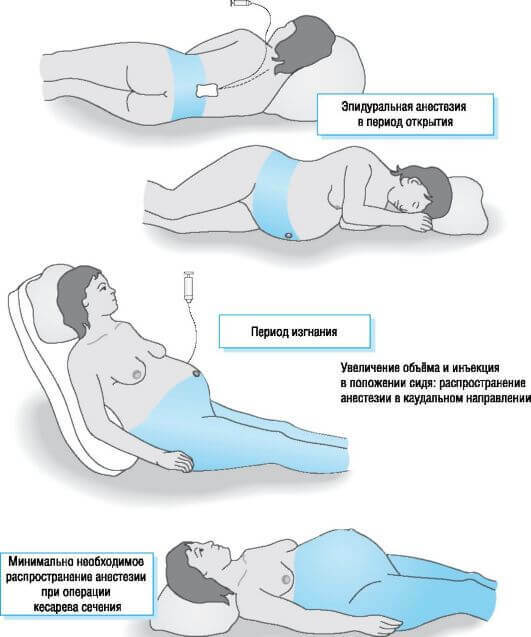
When carrying out epidural anesthesia is contraindicated
This type of anesthesia is considered to be quite a serious procedure, therefore, there are also categorical contraindications to the procedure.Moreover, they "work" for epidural anesthesia, carried out not only in gynecology, but in all other surgical interventions.
Contraindications to the type of anesthesia in question are:
- In the operating room there is no necessary inventory of .This applies, for example, to a device for ventilating the lungs, which may be necessary for the development of complications during the operation.
- Low blood pressure in patient .Specifically, the introduction of an anesthetic into the epidural cavity with a pressure of 100/60 mm Hg is contraindicated.Art.And below.This is due to the fact that during the type of anesthesia in question, the pressure naturally decreases.
- Diagnosed infectious diseases .It does not matter in what form they take place - in chronic or acute, first treatment is required.
- Pathological changes in blood tests of - for example, low platelet count, bleeding disorder, high leukocyte count.
- Pathology of the spine of , or anomalies of its development.It is the presence of a hernia of the intervertebral space or, for example, osteochondrosis, burdened with a strong pain syndrome.
- Any inflammatory and / or suppurative skin disease in the place where it is supposed to perform a puncture of the epidural space.
- Diagnosed cardiac arrhythmias .
Advantages and disadvantages of epidural anesthesia in cesarean section
As with any medical procedure, the type of anesthesia in question has advantages and disadvantages.Since most epidural anesthesia is used during cesarean section, we will consider the "pluses" and "minuses" of this particular variant.
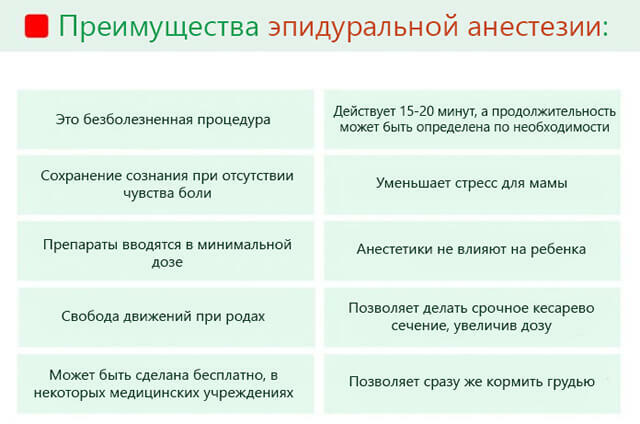
Advantages:
- the work of the cardiovascular system remains relatively stable, whereas in anesthesia, functioning is inhibited;
- injected anesthetic does not enter the bloodstream, so there is no toxic effect on the fetus;
- no intubation tube is introduced( this is necessary for general anesthesia), which means there is no irritation of the respiratory tract;
- epidural anesthesia, in principle, can be done with a full stomach( this is important for emergency operations caesarean section);
- does not provoke the development of hypoxia( lack of oxygen) in the mother and the fetus;
- possibility of prolonged anesthesia - first anesthetic is administered during natural delivery, then( if necessary), anesthesia is added and a caesarean section is performed.
Note: and the doctors and the parturient women themselves, one of the most important advantages of conducting epidural anesthesia during cesarean section operation, consider the available opportunity to hear the first cry of the newborn - the woman is conscious.
Of course, the type of anesthesia in question has drawbacks, and patients should be aware of them. The disadvantages are:
- an anesthesiologist's mistake in calculating the dose of anesthetic - this has a toxic effect on the brain, which is expressed in convulsions, lowering blood pressure to critical parameters, respiratory depression;
- mistaken introduction of a large amount of anesthetic into the subarachnoid cavity - leads to cardiac arrest and respiration;
- To ensure that epidural anesthesia does not pose a danger to the patient, it must be performed by a highly qualified anesthesiologist;
- between the administration of an anesthetic drug and the beginning of an operation should take an average of 10-20 minutes;
- in some cases there is incomplete anesthesia - this delivers discomfort to both the patient and the surgeon.
Many patients are confident that epidural anesthesia leads to various neurological disorders, including paralysis of the lower limbs.It should be clearly understood that neurologic abnormalities in the application of the type of anesthesia in question occur only in the case of trauma to the nerve root.And this can happen only in the absence of an anesthesiologist's experience - you can guess that for the epidural anesthesia it will never be sent to a young trainee or a recent graduate of a medical university.
Possible consequences of epidural anesthesia and complications
Each patient should be aware of what consequences and complications are possible after the application of epidural anesthesia. Specialists note the following:
- Sensation of numbness, tingling, heaviness in the lower limbs is the norm when introducing an anesthetic into the epidural space.As soon as the action of the anesthetic drug ends, discomfort and discomfort disappear.
- One of the normal reactions is considered and involuntary trembling in the lower limbs.It passes after a while and does not bring any consequences.
- An inflammatory process may develop at the site of injection.This means that the sterility rules were violated.As a rule, the problem is solved by applying ointments with antibacterial effect, which differ in local use.
- An allergic reaction may develop on the injectable medication of the analgesic effect.In this case, the doctor must interrupt the introduction of anesthetic and ensure that the patient receives antihistamines( for example, Suprastin or Dexamethasone).
- Against the backdrop of a drop in blood pressure( this occurs when an anesthetic is injected into the epidural cavity), nausea and vomiting may occur.At such complaints the doctor should spend symptomatic therapy by introduction of antiemetic / stabilizing preparations - unpleasant sensations disappear.
- In an inoculated child, an anesthetic of the type in question can dramatically decrease blood pressure.The woman's condition must be stabilized, so the doctor should have cardiotonic and / or infusion solutions( for example, Mesatin or Epinephrine).
- After epidural anesthesia, a patient may be bothered by a headache.As a rule, this syndrome disappears in 24 hours, but only if the patients keep the horizontal position all this time.In the case of a high intensity of headache, the doctor may prescribe the administration of drugs with analgesic effect - for example, Analgin.
- In case of mistaken introduction of an anesthetic into the vessel, acute intoxication of the organism may develop.The condition is severe, requires a long enough treatment, so the anesthesiologist must be sure that the needle is in the epidural space - this is controlled by aspiration.
- Periodically occurring back pain at the puncture site is due to traumatization of the spinal root.
Spinal / epidural / epidural / caudal anesthesia - what is the difference
Peridural and epidural anesthesia are two terms that denote the same procedure for anesthesia.But the spinal( it is also sometimes called cerebrospinal anesthesia) is an injection of a drug with the effect of anesthesia in the subarachnoid space.Indications for such anesthesia are the same as for the above-mentioned - cesarean section, surgical interventions on pelvic organs, urological and gynecological operations, surgical treatment of certain crotch and lower extremity diseases.
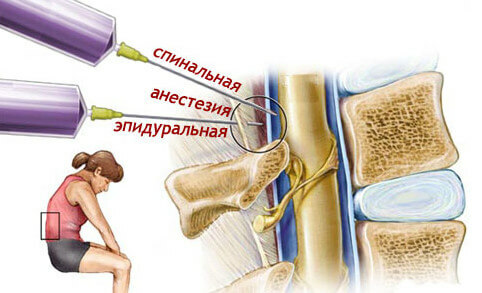
Quite often doctors combine two types of anesthesia, combine epidural and spinal. The result is:
- able to level out the shortcomings of anesthesia;
- strengthening of the action of an anesthetic;
- decrease in the number of injectable pain medications.
Usually, such combinations are used during operations on the intestines, joints and during the caesarean section.
Caudal anesthesia
With this kind of analgesia, the anesthetic is injected into the sacral canal - at this point the doctor can insert the needle into the end of the epidural space.By the way, in the world medical practice, the first epidural anesthesia was carried out precisely by inserting a needle into the sacral canal.Indications for caudal anesthesia are:
-
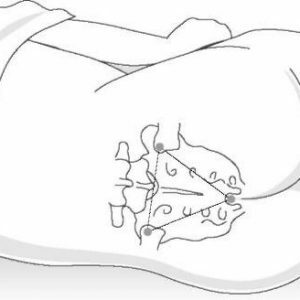 surgical interventions in obstetrics;
surgical interventions in obstetrics; - surgical treatment of diseases of the perineum, rectum and anus;
- operations on organs that are located below the navel;
- surgery in pediatrics - children always do caudal anesthesia;
- plastic surgery of the gynecological direction;
- Acute lumbosacral radiculitis.
Caudal anesthesia has pronounced advantages:
- it is convenient for the surgeon to work proctologically;
- anesthesia is carried out and in outpatient settings( treatment does not require placing the patient in a hospital);
- lowering blood pressure when administering an anesthetic is extremely rare.
Disadvantages of caudal anesthesia:
- the procedure is rather complicated;
- significantly increases the risk of infection at the puncture site;
- if it is necessary to provide long-term anesthesia and for this purpose a large amount of the drug is administered, then the patient may be poisoned;
- on the abdomen can not be performed;
- the interval between the introduction of anesthetic and the onset of the effect of anesthesia is greater than with epidural anesthesia;
- is a complete block of anal muscle cellulose, and in some cases it interferes with the surgeon.
The use of epidural anesthesia in surgical practice
This type of anesthesia is used not only in obstetrics and gynecology, but also in operations in other areas of medicine. Most often, epidural anesthesia is used when:
- removes appendicitis - appendectomy;
- surgical interventions on the rectum and sigmoid colon;
- operations on the bladder and prostate gland;
- removal of the uterus;
- hernia repair;
- operations on the stomach, but in this case a combination of epidural anesthesia and anesthesia is used;
- surgical intervention on the area between the anus and the genitals( perineum);
- operations in the rectum;
- urological operations;
- surgical treatment of vessels( eg, for aortic aneurysm);
- operations on the joints, bones and vessels of the lower limbs( for example, hip joint prosthetics).
In addition, this type of anesthesia is also used as an analgesic procedure - for example, with phantom pain after limb removal, pain syndrome in cancer patients, back pain, after severe trauma.
Note: for laparoscopy, the type of anesthesia in question is used extremely rarely, since this will require both the appointment of sedatives to the patient and the solution of the problem of oxygen starvation of the patient.
Drugs for epidural anesthesia
Many patients believe that for the anesthesia in question, doctors use only lidocaine, but in fact the list of medications that can be used for epidural anesthesia is quite wide. These authorized tools include:
-
 Trimecaine .Numbness begins 15 minutes after the introduction into the epidural cavity, lasts no more than 60 minutes.It is most often used for conducting combined anesthesia - epidural + anesthesia.
Trimecaine .Numbness begins 15 minutes after the introduction into the epidural cavity, lasts no more than 60 minutes.It is most often used for conducting combined anesthesia - epidural + anesthesia. - Mepivacaine .The action begins quickly, the duration of the effect is 1, 5 hours.Introduced through a needle or catheter, but not used as a prolonged anesthetic in parturient women - can get into the fetal blood.
- Dicain .The action begins only after 20-30 minutes, but the duration of anesthesia is 3 hours - this time is enough for most operations.It is necessary to carefully select the dosage, since even a small excess of the amount of the drug administered can lead to intoxication of the body.
- Chlorprocarin .Its effect begins in 15 minutes, the duration of anesthesia is a maximum of 60 minutes.It is often used for small operations on an outpatient basis.
- Prilocain .The action is the same as that of Mepivacaine.It is not used in obstetrics, since it can lead to a decrease in hemoglobin in both the mother and the child.
- Ethidocaine .This anesthetic begins to act after 15 minutes, and the effect of anesthesia is maintained for 6 hours.But specifically in obstetrics and gynecology, ethidocaine is not used for epidural anesthesia - it relaxes muscles too much.
- Bupivacaine .Within 10-15 minutes the patient can feel its effect, the duration of anesthesia is 5 hours.Often this drug is used to improve the condition of the mother, the anesthetization of labor, as it does not greatly relax the muscles and does not inhibit the generic activity.
Please note: Novocaine is also on the list of medications that can be used in epidural anesthesia.But at the moment it is used extremely rarely - doctors are given a choice of more effective and safe drugs.
Patients who are expected to undergo surgery need to know that there are a number of drugs that make epidural anesthesia impossible. These include:
- Tyclid;
- Warfarin( Coumadin);
- Plavix;
- Heparin( unfractionated);
- Rivaroxaban;
- Frakssparin;
- Tsibor;
- Enoxaparin;
- Arikstra;
- Dalteparin;
- Nadroparin.
In any case, if a patient waiting for surgery with epidural anesthesia takes systemically any medications, he must inform the surgeon about it.
Epidural anesthesia is a rather serious procedure that requires high qualification of the doctor.It is this anesthesia that allows most surgical interventions to be performed without the harmful effect of anesthesia.
Tsygankova Yana Aleksandrovna, medical reviewer, therapeutist of the highest qualification category



